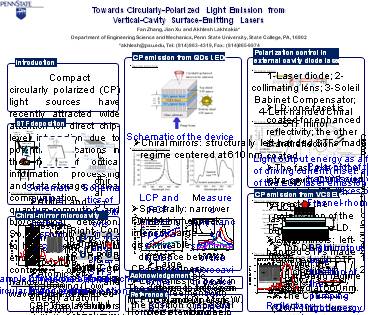Towards CircularlyPolarized Light Emission from VerticalCavity SurfaceEmitting Lasers - PowerPoint PPT Presentation
Title:
Towards CircularlyPolarized Light Emission from VerticalCavity SurfaceEmitting Lasers
Description:
Top DBR mirror replaced with CTF and chiral STF bilayers ... Fresnel-rhomb retarder. CP ratio=112. CP ratio=32. Ith = 46 mA. LCP lasing output ... – PowerPoint PPT presentation
Number of Views:39
Avg rating:3.0/5.0
Title: Towards CircularlyPolarized Light Emission from VerticalCavity SurfaceEmitting Lasers
1
Towards Circularly-Polarized Light Emission from
Vertical-Cavity Surface-Emitting Lasers Fan
Zhang, Jian Xu and Akhlesh Lakhtakia Department
of Engineering Science and Mechanics, Penn State
University, State College, PA, 16802 akhlesh_at_psu.
edu, Tel (814)863-4319, Fax (814)865-9974
Polarization control in external cavity diode
laser
CP emission from QDs LEDs
Introduction
- Device structure
- System setup
Compact circularly polarized (CP) light sources
have recently attracted wide attention for direct
chip-level integration due to potential
applications in the fields of optical information
processing and data storage, optical
communication, quantum computing, and
bio/chemical detection. So, it is highly
desirable to have on-chip CP light emitters with
precise controls over CP handedness and
wavelength. The authors report the development
of a class of chiral-mirror-based vertical-cavity
surface-emitting lasers (VCSELs). The advances in
sculptured thin film (STF) technology will
eventually lead to the development of a new
family of CP photonic devices that are efficient,
compact, and fully integrable into
optical/optoelectronic chips for a wide range of
applications of CP light.
1-Laser diode 2-collimating lens 3-Soleil
Babinet Compensator 4-Left-handed Chiral STF
mirror
- LD one facet is coated for enhanced
reflectivity the other is antireflection-coated. - The fast axis of the intra-cavity QWP was aligned
at 45with respect to the - polarization of the TE mode in the LD.
- Chiral mirrors left-handed STFs made of TiO2
with the circular Bragg regime - centered at 660nm.
STF deposition
- System lasing behavior
Schematic of the device
CP ratio112
CP ratio32
- Chiral mirrors structurally left-handed STFs
made of TiO2 with the circular Bragg - regime centered at 610 nm
- Device characterization
Polar plot of the normalized analyzer
transmission vs the angle between the optical
axes of the analyzer and the Fresnel-rhomb
retarder
Light output energy as a function of driving
current (Inset spectrum of the LCP laser
emission)
- Ith 46 mA
- LCP lasing output
- Side-mode suppression ratio is 26 dB
Schematics of depositions of CTFs and chiral STFs
Schematic of the basic system for PVD of STFs
CP emission from VCSELs
- Oblique angle deposition
- A tilted and rotating/fixed substrate corresponds
to chiral STF/CTF deposition. - Atomic self-shadowing (Low energy adatom
diffusion).
LCP and RCP emission spectra of the NQDs
confined in the chiral-STF-based microcavity
Measured reflectance spectrum of the microcavity
device for incident LCP light
- Device design
- Spectrally narrower FWHM higher peak intensity
large discriminable - difference between CP handedness.
- LCP emission peak in good agreement with the
position of spectral hole.
Chiral-mirror microcavity
- Top DBR mirror replaced with CTF and chiral STF
bilayers - The CTF (QWP) introduces a pi/2 retardance to
compensate the - polarization mismatch between the two
reflectors.
- Device characterization
- Large discriminable difference between CP
handedness is persistent under - different pumping light power.
- Spatially narrower emission angle (strongly
directed normal to the surface).
Acknowledgement
An example of well-developed circular Bragg
regime
Difference between chiral STF mirror and
conventional mirror
The authors thank Sean M. Pursel and Dr. Mark W.
Horn for providing help on initial STF
depositions.
- Circular Bragg phenomenon (CBP)
- A well-developed CBP displays high selective
reflection of CP light and is - confined to a defined spectral regime.
- Microcavity built with chiral mirrors
- Chiral STF mirror CP states preserved by
reflection. - Conventional mirror CP states NOT preserved,
due to p shift.
References
Reflectance spectra of the CTF and RH chiral STF
bilayers (Inset cross-section SEM image of the
CTF and STF bilayers)
Light output as a function of the pumping light
energy (Inset spectrum of the RCP lasing
emission)
A. Lakhtakia and R. Messier. Sculptured Thin
Films Nanoengineered Morphology and Optics, SPIE
Press (2005). F. Zhang, J. Xu, A. Lakhtakia, S.
M. Pursel, M. W. Horn, and A. Wang, Appl. Phys.
Lett. 91, 023102 (2007). F. Zhang, J. Xu, A.
Lakhtakia, T. Zhu, S.M. Pursel, and M.W. Horn,
Appl. Phys. Lett. 92, 111109 (2008). F. Zhang,
Ph.D. Dissertation, Pennsylvania State University
(2008).































